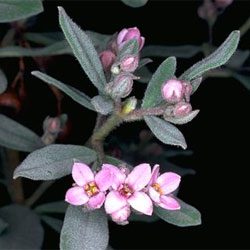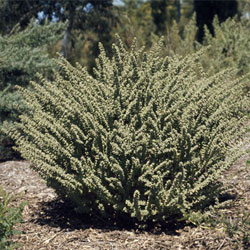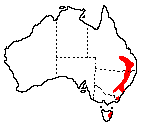Zieria cytisoides
 |
 |
Downy Zieria
The genus Zieria is confined to Australia and contains some twenty to twenty-three species. Zieria cytisoides is a low bushy shrub with attractive grey-green foliage. This species is widely distributed and is found growing naturally in many parts of Australia's eastern states.
 Without
any pruning at all Z. cytisoides forms an attractive compact shrub. The
specimens in the Australian National Botanic Gardens attain a height of 120
cm with a spread of 120 - 160 cm. Zieria cytisoides belongs to the Rutaceae
family, and like many members of this family the leaves are strongly aromatic
when crushed. This is due to the presence of oil glands in the leaves.
Without
any pruning at all Z. cytisoides forms an attractive compact shrub. The
specimens in the Australian National Botanic Gardens attain a height of 120
cm with a spread of 120 - 160 cm. Zieria cytisoides belongs to the Rutaceae
family, and like many members of this family the leaves are strongly aromatic
when crushed. This is due to the presence of oil glands in the leaves.
Zieria cytisoides does not have the very colourful fragrant flowers of some of its cousins, but its handsome, all-year-round foliage makes it an ideal contrasting garden specimen. The foliage is covered with fine, short hairs, giving it a soft, grey appearance and this accounts for its common name, Downy Zieria. The leaves are trifoliate and the obovate to elliptical leaflets are 1 - 1.5 cm long, with their undersurfaces much greyer due to the presence of extra silky hairs. The margins of the leaflets are curved or rolled underneath.
In spring small clusters of inconspicuous flowers appear along the branches. The petals are pink or white, 3 - 5 mm long and about twice as long as the sepals. The flowers closely resemble Boronia, but have only four stamens whereas Boronia has eight.
In the Australian National Botanic Gardens there has been no significant record of pests or diseases attacking this species. It does produce seed, but the best method of propagation is by cuttings. Cuttings 6 -8 cm long taken at most times of the year are easy to strike.
Text by ANBG staff (1975)
Name meaning: Zieria cytisoidesZieria - after M.(or J.) Zier, an 18th century Polish botanist; cytisoides - like Cytisus, the exotic Broom, but the allusion is not clear. |
![An Australian Government Initiative [logo]](/images/austgovt_brown_90px.gif)

